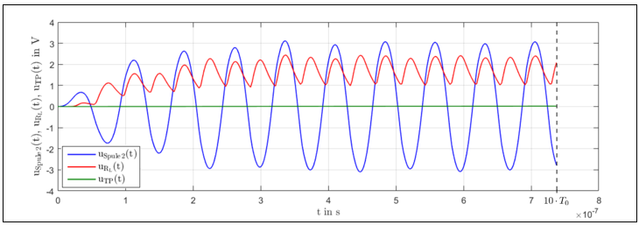Electric circuit analysis
Fundamentals of Electrical Engineering
In the courses ”Fundamentals of Electrical Engineering, Lecture“ offered separately for the bachelor’s degree programs “Electrical Engineering”, “Information and Computer Engineering”, and “Biomedical Engineering” the students gain first insight in the fundamental relationships observable in electromagnetic fields. Beside some very elementary considerations concerning the electric and magnetic field the focus of these courses is placed on electric circuit analysis. More specifically the students obtain knowledge on fundamental circuit analysis methods like the so-called nodal analysis technique, the description of time harmonic signals with complex phasors, the analysis of passive circuits with time harmonic excitations, the computation of the frequency response of frequency dependent passive circuits, and the description of the transient behavior of circuits with capacitances or inductances.
In the related exercise courses “Fundamentals of Electrical Engineering, Exercise” the students shall consolidate their theoretical knowledge in terms of selected exercises and homework in small groups. Additionally the students have the opportunity to learn on optional basis how to verify their computed results in terms of circuit simulations applying LTspice®.
The student’s fundamental knowledge in electrical engineering and circuit analysis is deepened in the practical laboratory exercises “Fundamentals of Electrical Engineering”.

Simple rectifier circuit with time-harmonic voltage excitation and corresponding current and voltage signals.
Fundamentals of Electrical Circuits and Electric Circuits and Multiports
Students from the bachelor’s degree programs “Electrical Engineering” and “Information and Computer Engineering” can further extend their knowledge in circuit theory in the courses “Fundamentals of Electrical Circuits, Lecture” and “Electric Circuits and Multiports, Lecture”. In these two courses, the students learn further more specific circuit analysis techniques as well as the description of operational amplifiers in terms of controlled sources and their incorporation in the classical circuit analysis methods. Different two-port and multi-port description techniques are also part of the course contents as well as resonant circuits and transient circuits with more than one passive reactive component. In addition, the student’s signal analysis skills are deepened in these two courses. They learn how to describe time-periodic signals in terms of Fourier series and obtain knowledge about the application of the Laplace-transformation to describe transient system responses of arbitrarily excited circuits.
For both courses also exercise courses are offered by the IGTE. In these exercises, the students shall consolidate their theoretical knowledge in terms of carefully selected examples, homework in small groups as well as circuit simulations with LTspice® and signal analysis with Matlab®.
After successfully completing the courses related to electric circuit analysis and multi-port descriptions, the students have gained a solid base on analysis techniques that are the prerequisites for circuit related courses in higher semesters. A strongly circuit analysis related student project should exemplarily show the competences which can be developed while attending the circuit related courses at the IGTE. In this project an adapted modified nodal analysis technique was developed to compute the circuit-like description of a coupled loop antenna system for an NFC application. Here the circuit-like description of the loop antennas was obtained from the so-called Partial Element Equivalent Circuit method. The aggravating circumstance in this project was the incorporation of non-linear electric circuits (e.g. diodes) and an efficient computation of the steady state solution. The method was verified on a simple rectifier circuit.

Two close coupled NFC loop antennas with the corresponding non-linear electric circuit connected to the antenna terminals.

Computed voltage signals at the non-linearly loaded NFC loop 2 for a time harmonic excitation of the NFC loop 1.
